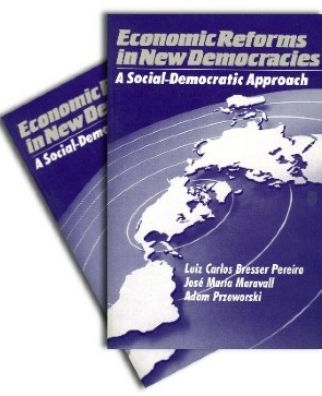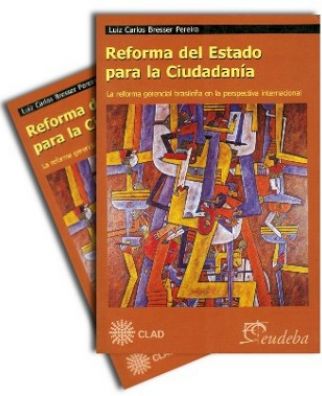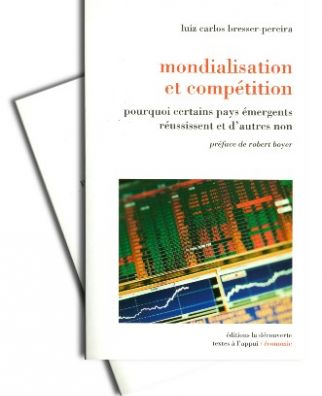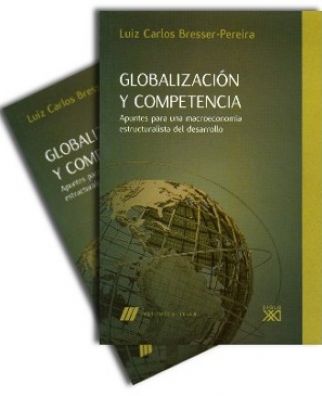2007. Paper
ECONOMICS
ECONOMIC DEVELOPMENT THEORY
2006. Economic growth is the outcome of a national strategy of development. The characteristics and main tensions involved in these national strategies discussed. See a more complete version in English.(Paper: Revista de Economia Política)
2006. Economic development defined using a historical method instead of a normative, or a hypothetic-deductive one. (Texto para Discussão 157 EESP/FGV)
2005. Economic growth is the outcome of a national strategy of development. The characteristics and main tensions involved in these national strategies discussed. Texto para Discussão que originou "Estratégia nacinal de desenvolvimento" e "National development strategy: the key institution"..
2006. A critique of the two dependency theories (associated and super-exploration) which intended to be an alternative to ISEBs and ECLACs view of Latin American development. Only a third version - national-dependent theory - is consistent with the nation building and growth. Portuguese and English versions available.(Paper)
2005. A critique of the two dependency theories (associated and super-exploration) which intended to be an alternative to ISEBs and ECLACs view of Latin American development. Only a third version - national-dependent theory - is consistent with the nation building and growth. English and Spanish versions available.(Paper in edited book)
2005. A critique of the two dependency theories (associated and super-exploration) which intended to be an alternative to ISEBs and ECLACs view of Latin American development. Only a third version - national-dependent theory - is consistent with the nation building and growth. Portuguese and Spanish versions available.(Paper)
2001. Edit book with José Marcio Rego. Papers analysing Celso Furtados contribution to economic theory. (Book: Editora 34)
1994. There are three models of capitalism: the American, the Japanese, and the European or social democratic. The choice criterium is efficiency - what will lead Latin American to choose a combination of the social-democratic and the Japanese (developmental) model. As to democracy, it is a end in itself or a means to freedom and peace, not to economic development. Thus, trade-offs between growth and democracy should not be considered. (Published only in this website)
1992. A slightly modified version of the Magna Class at the XVIII ANPEC’S Congress (National Association of Graduate Courses in Economics), Brasília, December 4, 1990.
1986. The classical model of development with inverted distribution and three types of technical progress. A critique of Marx's falling tendency of the rate of profit. Chapters 3 and 4 of Lucro, Acumulação e Crise) (Paper: Revista de Economia Política)*
1986 - Book on the phases of capitalist development and the distribution of income using Marx's model of the falling tendency of the rate of profit. Atualized in the apendix with the paper, "Growth and distribution: a revised classical model". First edition, 1986; second edition, em Kindle e em pdf .
1982 (Article: Folha de S. Paulo, 09.05)
1978. Multinational entreprises involve a new form of dependency, requiring carefull scrutiny. Brazil does not need so much of capital as it is said. The Brazilian bourgeoisie is associated to multinationals, but the state's technobureaucracy is not, and may be a source of national autonomy. (Paper: Encontros com a Civilização Brasileira)*
1978. Industrial civilization involved two creative revolution: the capitalist and the scientific revolution. But it threatens freedom. (Review of Celso Furtados book "Criatividade e Dependência na Civilização Industrial, in Revista de Economia Política)
1977. The planning state and the producer state in industrialized underdevelopment or the developmental state. (Short paper)
1977. An analysis of the modernizing, authoritarian and income concentrating character of the technobureaucratic-capitalist state, and of the respective model of development: "industrialized underdervelopment" (Book: Editora Brasiliense). Esgotado nas livrarias. Disponível in PDF format.
1975. The basic characteristics of growth model that prevailed during the military regime: the technobureaucratic-capitalist model of industrialized underdevelopment. In macroeconomic terms, on the supply side, it was based on the production of luxury goods; on the demand side, on the concentration of income from the middle-class upwards. Portuguese version available.
1975. The basic characteristics of growth model that prevailed during the military regime: the technobureaucratic-capitalist model of industrialized underdevelopment. In macroeconomic terms it was based on the supply side on the production of luxury goods, on the demand side, on concentration of income from the middle-class upwards. French version available(
1975. The Harrod-Domar model of growth is consistent with factor substitubility provided that a coefficient of substitution of capital for labor is added. This formalization is done here.(Paper em Estudos Econômicos)



























